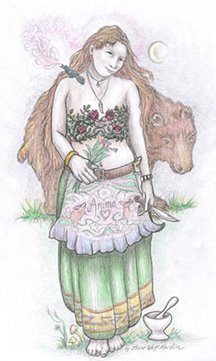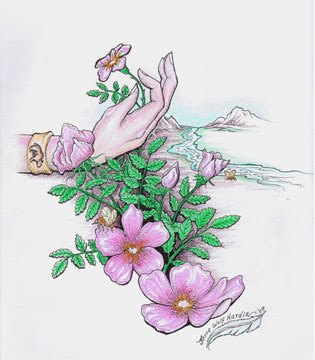
You remember that toothache I talked about a few posts ago? Well, despite repeated attempts with various herbs including Oregon Grape Root, Usnea, Redroot, Balsamroot and Echinacea, I was unable to shake the infection that seemed to just roam throughout my mouth. The herbs managed to keep the pain and swelling in check, but never completely resolved the problem. Strange, as I've treated other toothaches and infections with these same formulas many times before. Nevertheless, it provided a valuable opportunity for exploring new herbs for infection and pain.
With no dentist nearby, I sat down to puzzle about what other local herbs might work. I do have a supply of Goldenseal and few other herbs that were applicable to the situation but I was more interested in trying a local herb that I hadn't yet used in this capacity. Alder, a tree who's name means "Healing Woman" by some indigenous tribes, came to mind as a strong antibacterial alterative with an affinity for the lymph system. Since swollen lymph nodes had been part of the toothache's symptoms I figured this made the Alder especially appropriate. I had a tincture I'd made early this Winter of dried bark, catkins and cones (fresh bark can be emetic). While Alder is often called another simple astringent, some herbalists (including Idaho herbalist Darcy Williamson) has found it to be effective against Staph, Pseudomonas and other bacteria. It's also a great allergy preventative, skin healer, general cooling alterative and lymphatic. And it IS astringent, though not as much as say, Dock or Alum root.
So I gave it a shot, taking two dropperfulls 3-4 times a day. And I'll be damned if it didn't decrease the small but steady ache to nothing in three hours, all swelling gone in a day and gum sensitivity disappeared in two days. Seeing how Alder is such a common riparian tree (a far more common plant than Oregon Grape Root) in my canyon home I'm very excited to utilize it more often for various kinds of infection.
It also seems to reduce headache pain, and definitely has a strong effect on the GI system. It tends to be quite cooling and drying and it's emphasis appears to be on moving and balancing fluids through the blood, lymph and immune system. I've found it to work quite well with Sage. Dr. William Cook said:
The bark is the medicinal part, and is readily acted on by water. It is mildly astringent, and slowly stimulating to the cutaneous and renal secretions. It is good as an alterant in the treatment of scrofula, scrofulous and cachectic ulcers. The profession have by no means given to the article the attention it deserves; but have sent abroad for sarsaparilla, when the despised alder at their door is probably quite as valuable, especially when combined with suitable stimulants. A strong decoction of the article is a useful wash in scrofulous and venereal ulcers, and in chronic ophthalmia; and the same has been used as a popular drink in sub-acute diarrhea, and will be found a good injection in leucorrhea..

I've also used the leaves and bark infused into oil with very nice results as a general salve, especially when used for skin disorders like contact dermatitis, eczema and psoriasis as well mouth sores and ulcers. Nice combined with Rose, Sage or Elderflower/leaf.
A member of the Birch family, our Canyon Alder (Alnus oblongifolia) has beautiful silver bark with an underlying skin of blood red revealed by the scratching of bear claws and elk antlers (who are both quite fond of this tree). It lives right on the river bank with its roots dangling in a silver web in and just above the water. This tree has always spoken to me of the balance of fire and water, of rebirth and change. My partner Jesse Wolf Hardin wrote eloquently of Alder's mythological and spiritual aspects in his upcoming novel, The Medicine Bear:
The alder would have felt special to Omen even if she had never learned any of its story, or learned to read by studying its myths. She loved that it had been long known as the King Of The Fairies, that the faces of the Sacred Kings during the Midsummer rituals were painted with the red dye of its inner bark. That the fairies were said to use the Alder catkins to dye their clothes, thereby making themselves invisible to human eyes. That while its wood burned slow, it nevertheless made the best and hottest charcoal, and had once been the choice of medieval warriors for forging their magically imbued swords. That woodsmen would sometimes strike the silvery barked trees with an axe, and then upon seeing the bright red flesh beneath, be reminded of blood and made too sympathetic to continue an assault. For these reasons and more, the alder was considered to embody the power of fire. And because of the way it turned water into steam, it was called the Tree Of Resurrection by Homer. The alder was the botanical Phoenix, Omen had decided... the leaf-feathered firebird of rebirth.
This is a plant with many facets and faces, and one too little explored in modern American herbalism. If anyone else uses Alder medicinally or otherwise I'd love to hear about your experiences. Expect more posts on this remarkable tree in the future.
Resources:
Healing Plants of the Rocky Mountains by Darcy Williamson
Medicinal Plants of the Pacific West by Michael Moore
Edible and Medicinal Plants of the Rocky Mountains and Neighboring Territories by Terry Willard
Sacred Plant Medicine by Stephen Buhner












6 comments:
Just wanted to say how inspiring your blog is- and how much I love herbs, AND the Gila Wilderness-
Live it,Lady!
oooh thanks for this post kiva. alders were everywhere in the mountains of the southwest and I never really got around to getting to know it. I'm really hoping I can do so this year in the rockies. But only if summer comes. It's snowing again!
:)
Very insightful blog! I've been searching for natural antibacterial remedies to alleviate a recurring small intestine bacterial overgrowth. So far peppermint and oregon grape root work, but I'd bet adler would too.
Hi, just last week harvested little bit of alder bark from along side the Raging River near Fall City, WA (outside of Seattle), first time i have harvested it. Also saw your blog today for first time. Me like. Our NW alder is Alnus rubra, red alder, though I assume active constituents are same as yours. Wanted your opinion, when you are peeling bark, how deep do you go? Down to the slimy wood part? Or just the very outermost bit? Are you looking for trees of any certain size? Any comments on practix of harvest would be appreciated. I myself carved in with knife to the wettish slimy inner layer, taking little hunks here and there in a grove of trees. The bark was real flaky and kept falling away. Wasnt sure if I was wounding tree too much. Ill have to go back and check the cuts I made.
Interesting to compare uses of various Alnus by different coastal groups. Gunther (1930s) in her NW ethnobotany (Puget Sound) wrote that the bark was boiled and tea drunk for colds, stomach trouble and scrofula sores. Cones were eaten to stop dysentry and catkins chewed to cure diarrhea. Ointment of bark used for eruptive skin diseases. Also, rotten alder wood was rubbed on the body for a aching bones.
What is it with flowing water and the salicin? The cottonwood, alder and willow are all primary succesion river trees, and they are all good analgesics in the pacific northwest. anyways...like your blog.
When I gather bark from trees, I always collect live twigs from the tree us rather than injure the tree by taking strips or chunks of body bark. I make exceptions when beavers chew down trees, or they're felled for some other reason. Twigs work just as well and are much easier on the tree. And then you can just used the chopped up twig rather than separating the bark bits. The outside bark is commonly thought of as being dead, it's the inner bark that's usually considered medicinal.
I'm interested to hear how it goes for you using your local species of Alder. Have you used Alder as an analgesic?
Thanks for reading everyone!!!
When I was about 8 or 10 yrs. old I
had boils on my back. 3 or 4 of them. Very painful. Then my father
went to the creek bottom and got some Black Alder and peeled the bark from a limb and made tea which I had to drink. Very bitter!!!!!!!! This remedy was handed down to him from his ancestors who were Indian (Delaware I believe}. We are from western Pa. I haven't had boils since. Hope this helps someone.
Post a Comment